How to Understand The Electrification of Production Plants
Executive Summary
- Fossil fuels were instrumental in promoting the first industrial revolution.
- We cover power stations’ growth, the line shaft in factories, and how the steam turbine improved and factory changes.
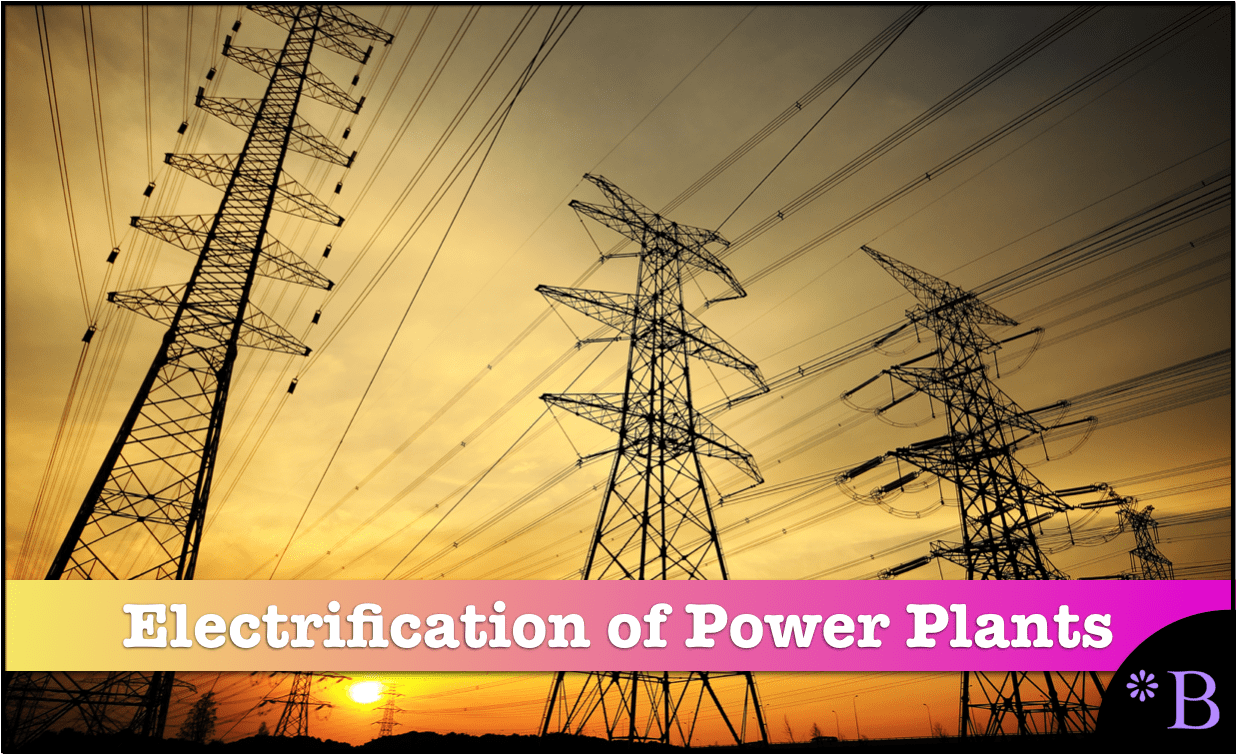
Introduction to Electrified Manufacturing
Infatuated with recent technology developments, the far more essential technology improvements that came before information technology. This article will learn about one of the most critical developments in manufacturing and the overall standard of living in developed countries. This is the topic of the electrification of production.
The Foundation of the Industrial Revolution
Fossil fuels and manufacturing growth during the first and second industrial revolutions are often written about as separate phenomena, but they reinforced one another. The localized combustion of fossil fuels powered the first industrial revolution. This significantly increased manufacturing power and allowed production to be flexibly located instead of finding manufacturing next to natural energy sources, such as rivers. In Europe, mills, such as those designed for grinding grain, malt, and meal, were most often located next to rivers so the waterpower could be harnessed to perform the grinding.
However, waterwheels — where the shaft was connected to gears and a series of belts and pulleys, were also used in manufacturing. In the first industrial revolution, most factories had their on-site steam engine or a power building in the middle of small factories that could be rented. A single steam engine powered a shaft for each rental factory surrounding the power building.[1]
The Second Industrial Revolution
The second industrial revolution (marked by the assembly line and mass production) was powered by far more efficient centralized combustion of fossil fuels at power stations. The first central power station was built in Surrey in the UK in 1881. In 1884, the steam turbine invention significantly improved power generation efficiency, particularly central power generation, which could more easily leverage the power generation economies of enormous steam turbines.
The Steam Turbine
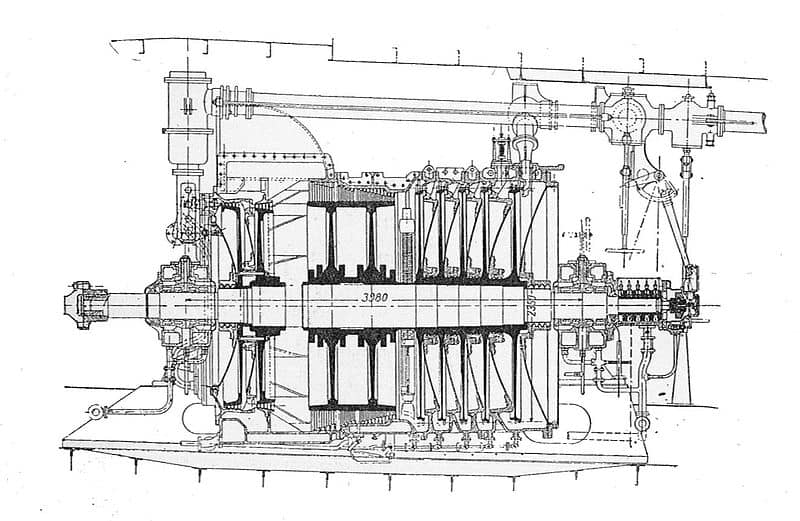
The steam turbine converts fossil fuel energy into mechanical energy. It was subsequently converted into electrical power, one of the technological advances that made the relatively efficient conversion of fossil fuels in central power stations (that powered factories), ships, and rail. As time passed, the steam temperature increased, as did the shaft’s rotational speed and the size of the steam turbines. All of this led to increased efficiency and lower electricity prices.
Centrally run steam turbines run by power utilities can also be run continuously – the so-called base power, with peak power provided by internal combustion engines. Interestingly, a steam turbine is based on the same principle as the water wheel, humanity’s first attempt to leverage the mechanical power of the sun’s stored energy for manufacturing purposes.
The Growth of Power Stations
By 1890, 1000 central power stations were in operation in the US and 3620 in 1902.
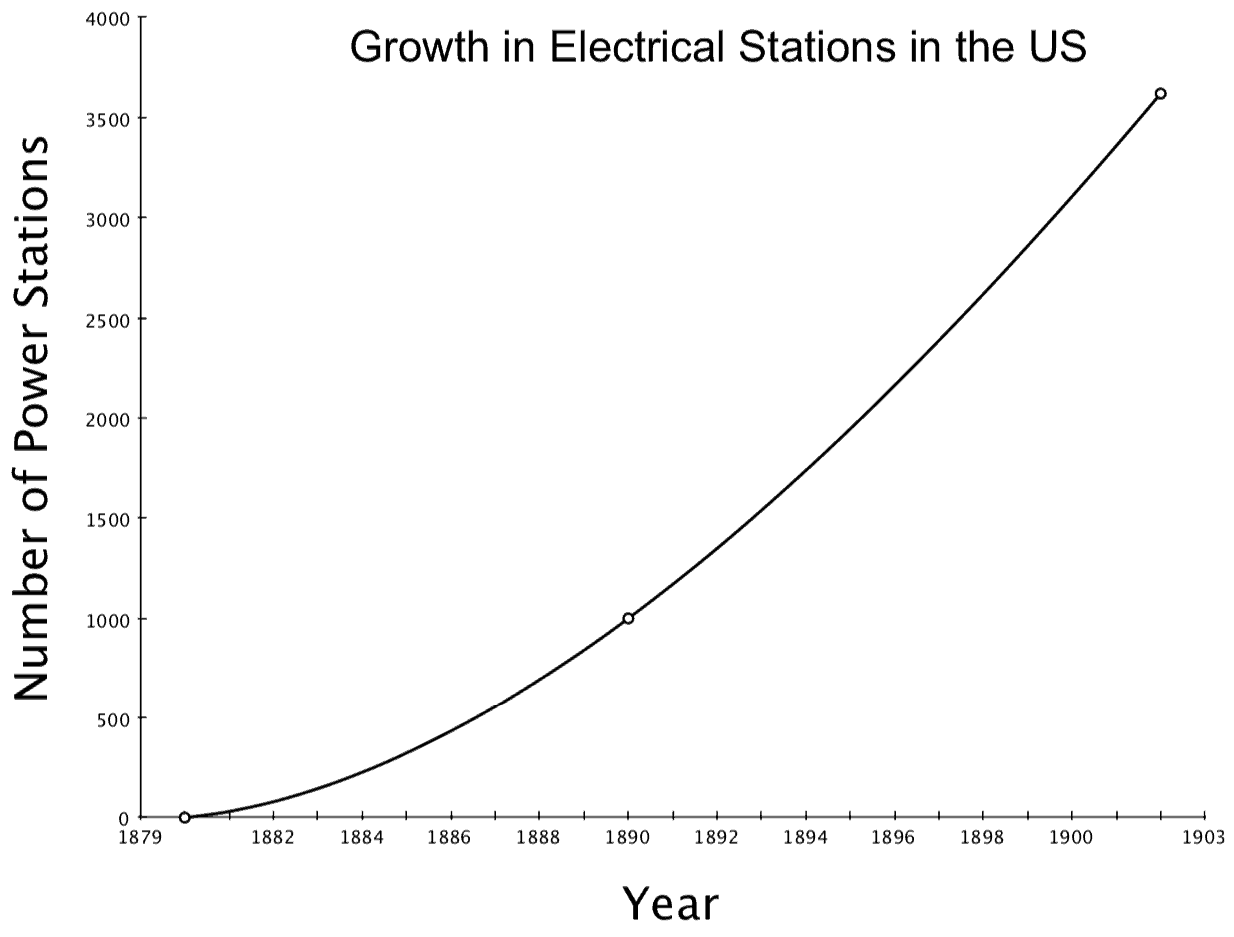
This graphic shows the extreme growth industry that power generation once was.
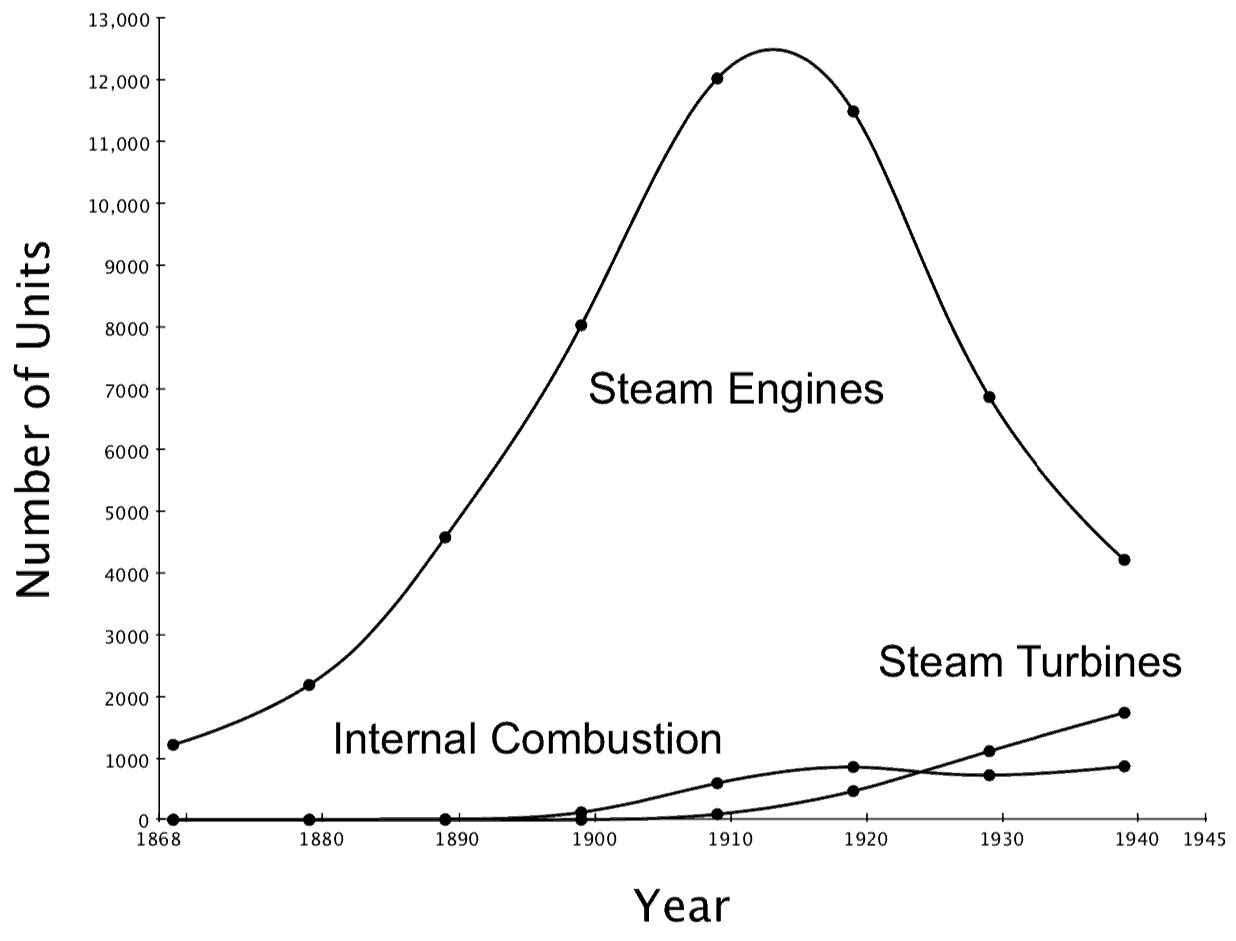
- This graphic shows steam turbines, and partially internal combustion engines came to replace steam engines. Central power plants began with steam engines, just as we’re used in factories. However, the actual growth in the authority plants came with the introduction of steam turbines, which had tremendous economies of scale. Steam engines were one of the high-growth areas of the economy up until roughly 1917.
- We can see from this graphic that the power output from each steam turbine was more significant than that for each steam engine. Even while power use is significantly increasing, the number of steam engines is declining rapidly, while the number of steam turbines is growing far more slowly.
Displacement of the Rise of the Internal Combustion Engine
The rise of the steam turbine even displaces the increase in internal combustion engines (that is, internal combustion engines for power generation, not internal combustion engines for transportation – which is not counted on this graph)[2]
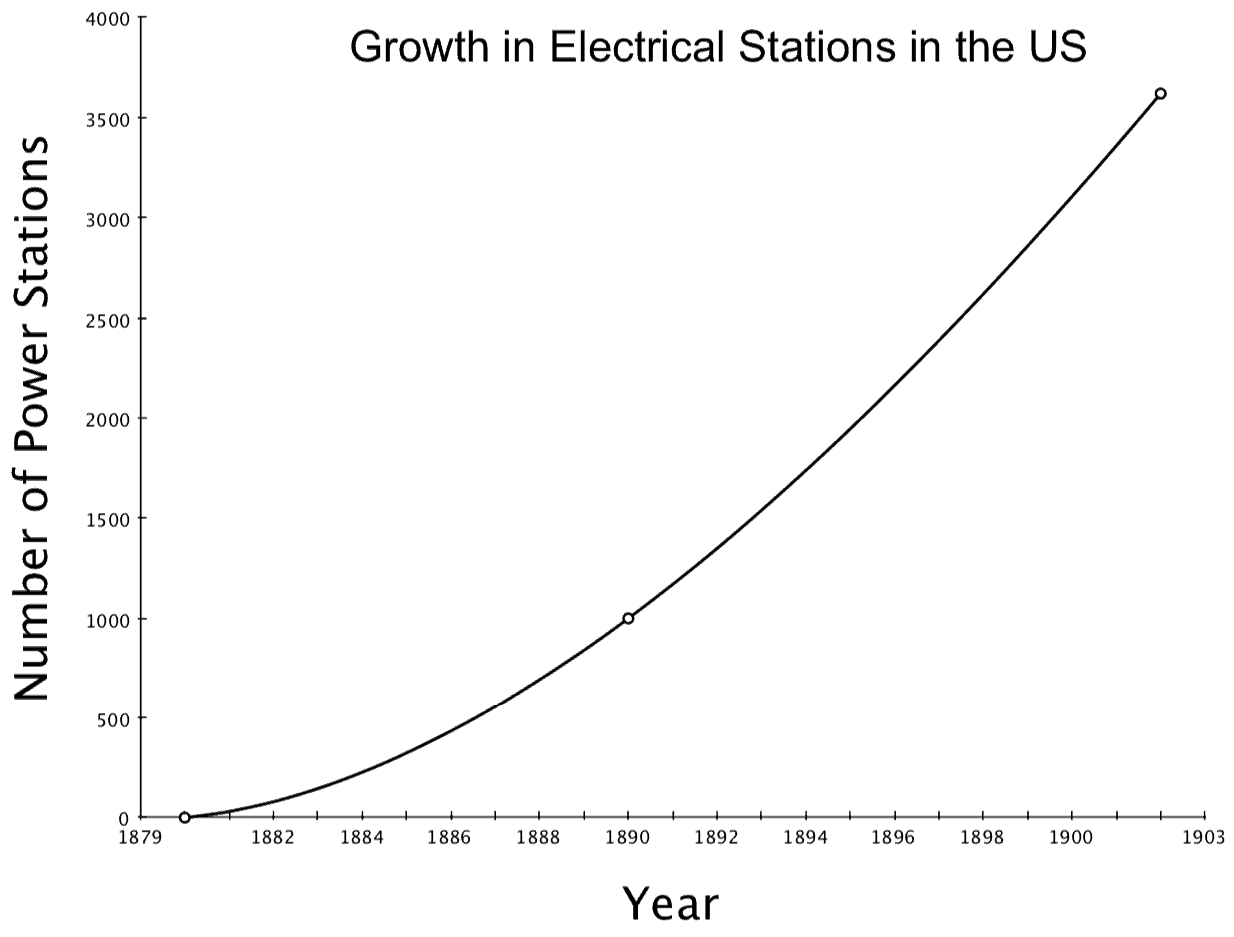
This shows how electrical drives (unit drives) took over for direct drives in factories. From roughly 1919, being completely inconsequential in factories, electrically driven unit drives surpassed direct drives (line shaft was driven) by 1920
This was enabled through the invention of electrification and the electrical grid. Electrification, or the electrical grid development, occurred from the 1880s to 1950 in the US and the UK. On-premises steam engines drove manufacturing machinery in 1900. However, by 1920, electricity- that is, power generated from a distance- was produced by a remote steam engine and then later by a remote steam turbine. A transition from the engine to the turbine was mainly completed by 1917, driving electrical motors on the factory floor, which was more common in driving machinery than locally generated power. The growth of centralized power generation was speedy. By 1914, the power generated by electrical utilities surpassed all the power produced at factories in the US.
Understanding the Line Shaft in Factories
Before electrification, power was supplied from a steam engine through something called a line shaft. This was named so because there was a single central shaft in the factory. This concept goes far back when similar systems distribute power from a single source – such as an animal or waterwheel to multiple workstations.
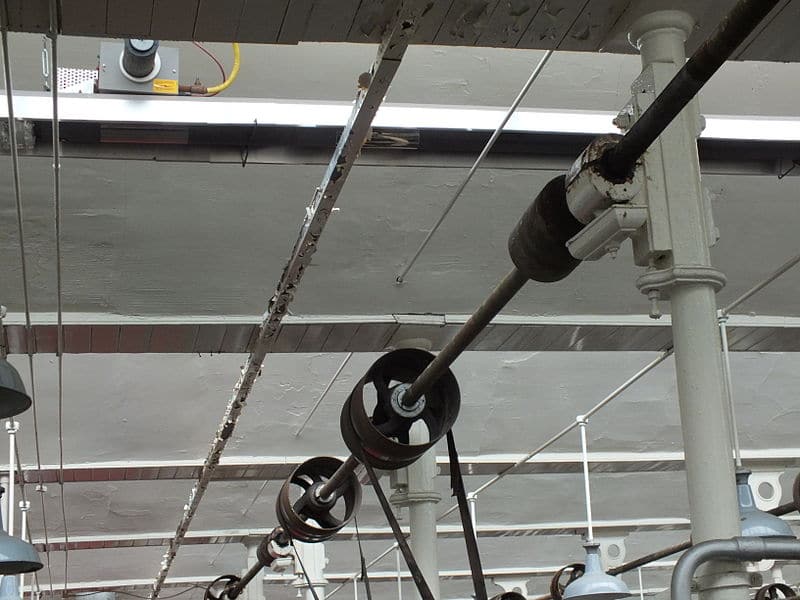
Notice the line shaft. The shaft here is multiple connected pulleys (the cylinders) that transfer the power to another pulley below, connected to the driving spindle, which drives the machine.[3] A pulley not attached to the driving spindle was called the “idler” and was primarily neutral. The belt was put on the idler either when the operator needed to switch gears or when the machine was not in use—not consuming any of the steam engine’s power. However, the top pulley still needed to turn, and any turning pulley even consumed energy in the form of friction. It is estimated that the power loss across the shaft was usually more than 25%, and roughly 1/3 to 2/3s of the power created in the factory’s steam engine was consumed in the friction of turning the various shafts. From their invention, many improvements were made in the belt (changed to a rope) and to the pulley (The diameter of the pulleys was increased to improve mechanical efficiency.)[4]
Pulleys and Workstations
Different pulleys would be connected to multiple workstations. Any single shaft could run close to the width of the factory. Belts could connect shafts so that rows of shafts with workstations at each row. Some factories reached more than a mile of line shaft. The Queen Street Mill had 600 looms driven by a single 500-horsepower coal-fired steam engine.[5] The line shaft design would have limited the factory’s layout because the machine layout was partially based on the limitations of the shaft locations and the belts.[6]
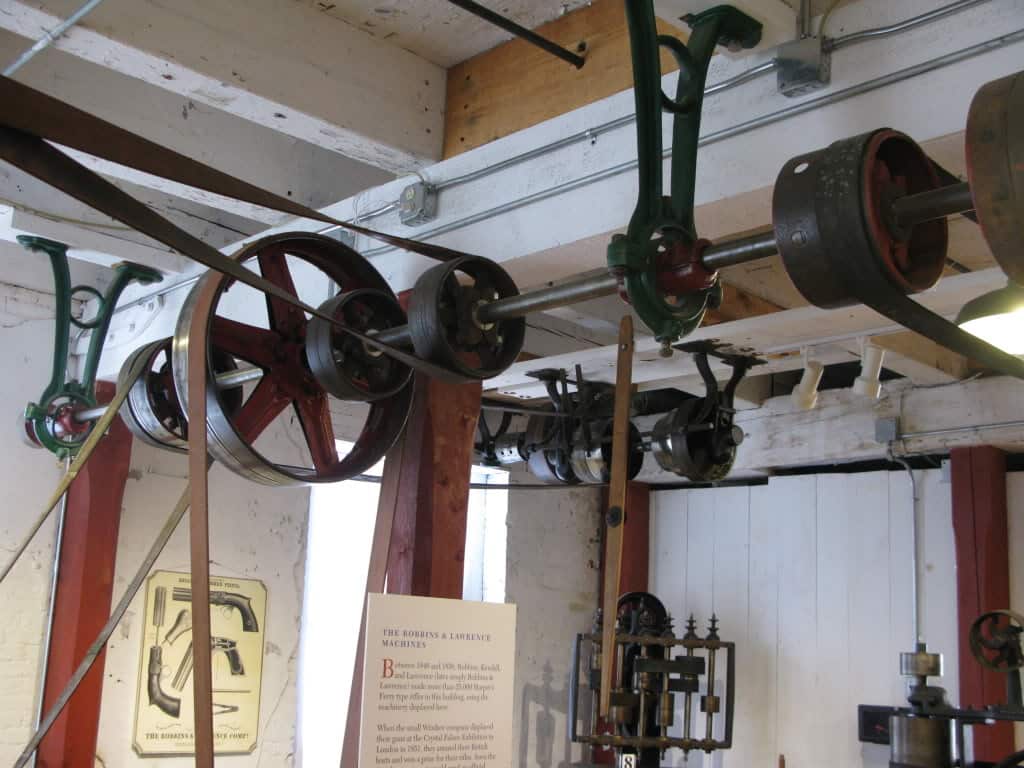
Here is how power was transferred from one shaft to another. The workstations had different “gears” based upon different circumference lower pulleys, which could move the belt to the receiving side.
If a manufacturing item had a few single workstation types, the line shaft method of power distribution was not all that complex to design. However, in other manufacturing environments, there were many machines and a great variety of machines – which means an intricate design for distributing this power from a single source of power in the factory.
The Rise of Electrification
With the rise of electrification, local electrical motors enabled unit drives. The unit drives connected directly to the machine’s drive shaft significantly reduced the power loss caused by the multiple shafts, belts, pulleys, and transfers between shafts. There’s also no power loss in turning pulleys for machines not being operated. This transition from line shaft-driven factories was not smooth. Machines powered by belts and shafts had to be redesigned to accept the electrical motors’ input. Existing factories needed to be reconfigured; the plant layout philosophy had to be rethought. The many implications of how power was delivered to factories was a significant adjustment that took decades to sort out how the new, more convenient, sophisticated power source was fully leveraged for manufacturing efficiency. It drove improvements in many areas and evolved as new improvements from many areas (such as improved metallurgy and machine tools) were incorporated into successive new factories and factory retrofits. The Detroit Edison Company, in 1905, lent motors to manufacturers and then installed them to apply the motors correctly.[7]
In essence, the power company was providing consulting along with their motors. They undoubtedly did this because they knew the motors’ value, knew they would drive electrical consumption, and knew that the manufacturers they installed the motors could not do it themselves.
What became clear is that the electric motor and the tool needed to be primarily designed for each other. These are capabilities that we all take for granted today. For instance, when we buy a laptop or cellphone, we receive a power supply (and battery) designed specifically for that item’s needs.
As I will describe in the following article, the power benefits of electrification and unit drive were just one small part of the overall value proposition.
The Steam Turbine Improves, and the Factory Changes
As more advancement occurred in steam turbines, the cost advantage continually migrated to power’s central production. According to the publication From Shaft to Wires, it was not the primary motivation. This is because the electricity cost was generally around .5 to 3 percent of the item’s total production cost. However, electrically delivered remote power allowed for the following:
Reduced Fire Hazard
They reduced the fire hazard of having a power generator right in the factory. This lowered risk allowed manufacturing companies to build much larger buildings without the concern that a local power generation fire could consume the entire building, leading to further increases in manufacturing efficiency.
More Productive Machinery and Working Conditions
A factory of the same size could hold more productive machinery if it did not need to have a power plant contained within it.
“At first, electrical power was used in manufacturing environments where cleanliness was more critical such as textiles. This was a switch between power sources, but not much else. However, as time passed companies began to take advantage of electrical power in ways that made the plant layout more efficient. “Machinery could be arranged on the factory floor according to the natural sequence of manufacturing operations, minimizing the handling of material. The ability to arrange machinery irrespective of shafting made all space in the factory equally useful and not only for storage, as heretofore.” – From Shaft to Wires
The manufacturing environment improved.
“Lights could be provided in spaces formerly occupied by belts, pulleys, and shafts. Factories were vastly cleaner and brighter after the adoption of the unit drive (electrification), and many observers felt this had a very positive impact on the quantity and quality of work.” –From Shaft to Wires
With the removal of overhead shafts, cranes could perform lifting previously performed manually. Cranes have a very positive effect on factory productivity.
Waste Reduction and Productivity Enhancement
Unit drive improved the ability to perform precision manufacturing and to have less waste. It eliminated one of the significant problems, which was belt slippage. Productivity was enhanced with a unit drive as there was much more control over the machine’s drive speed. While pulleys had few gears, unit drives had a gearbox, increasing and decreasing in rotation far more incrementally. This allowed the speed to be matched very carefully with the best speed for the manufacturing process. This was very much true with direct current motors. However, with the introduction of alternating current electric motors, which had some advantages over direct current motors, and the alternating current was increasingly supplied because of its easier transmit ability over distance, the alternating current induction motor was introduced.[1]
Machine Independence
Instead of running power through the entire factory to just power a group of machines, any machines could be run independently of the rest of the factory. On the other hand, any group of machines could be turned off.
Reduced Plant Cost and Increased Plant Location Flexibility
Without concern for the requirements of housing a power plant in the building, factories could be built more simply and less expensive.
Factories could be built in more geographic locations than previously, as power could be delivered to any site where the power grid reached.
“…large factories did not have to be located adjacent to sources of water power, nor did they have to be designed for a large steam engine if it was particularly inconvenient to supply the engine with coal.”– From Shafts to Wires
Overall Power Efficiency
Electrically driven motors were more efficient than single-shaft steam engines regarding the reduced shafting of the reduced number of belts. Electrification also meant more uptime, as the factory was not dependent upon a single-line shaft. This was true in two different but related ways. First, the central power plant’s power was more consistent and reliable than the power generated locally at the factory. Henry Ford leveraged electrification in all these dimensions when he introduced the most automated assembly line to date in his automotive factory. Henry Ford is on record saying he could not have set up his assembly lines, at least like he did, without electrification. Ford was certainly not the only one to adjust its factories. The electrification of factories changed factory layout in many different areas, not only for assembly line operations.
As the graphic above shows, centralized power generation became very efficient. The ability to transport energy so much easier with the development of alternating current is becoming more efficient to import and export power between areas serviced by a centralized power plant rather than increasing production at one power plant. That is continuous production — but at a specific level, was so efficient that it made sense for the construction of power plants to build in excess capacity. This could be sold and sent to other regions during periods of low power consumption and to buy power when the opposite was the case.
A National and Even International Power Grid
Unbelievably, power is now shared across countries and even across continents. Some plants are called baseload plants and are in continual operation, including nuclear and coal-fired. Other plants are called peak power plants, powered with higher-cost energy sources such as natural gas, which can generate batch power, bringing up power when needed and cycling down when it is not. Even across thousands of miles, energy can be transported at roughly 1/2 its generation cost. Therefore, selling energy to the grid makes sense if a power plant has excess and vice versa. Electricity can be transferred very close to the speed of light — therefore, transmission from any point to any point — as long as the transmission lines exist, can handle the load and are in good functioning order — can occur substantially instantaneously.
Long-distance power lines enabled power stations to connect and to manage and balance the load by sending energy — at a cost — across these lines.
Fossil Fuels, Electrification, and Manufacturing
Fossil fuels and manufacturing growth grew during the first and second industrial revolutions. However, they are often written about as separate phenomena. But in fact, they reinforced one another. The localized combustion of fossil fuels powered the first industrial revolution. This increased the power that was available to manufacturing. It allowed manufacturing to be flexibly located instead of manufacturing next to natural power sources, such as rivers. In Europe, mills, such as grinding grain, malt, and meal, were most often located next to rivers. This was so the water power could be harnessed to perform the grinding. Yet waterwheels — where the shaft was connected to gears and a series of belts, were also used in manufacturing.
The Second Industrial Revolution
The second industrial revolution (marked by the assembly line and mass production) was powered far more efficiently. It relied upon efficient centralized combustion of fossil fuels at power stations. The first central power station was built in Surrey in the UK in 1881. In 1884, the invention of the steam turbine improved power generation efficiency, particularly central power generation. This could more effectively leverage the power generation economies of enormous steam turbines.
The Assembly Line
Henry Ford’s association with the assembly line is one of the most documented topics in industrial history. Henry Ford leveraged the benefits of electrification in many dimensions. He did this when introducing the most automated assembly line to date in his automotive factory. Yet, Henry Ford is on record saying that he could not have set up his assembly lines, at least like he did, without electrification. This critical point seems to be papered over by industrial history. Electrification is the delivery of power to a manufacturing plant through two principal ways:
- From a plant nearby or inside the factory.
- From the electrical grid
The first electrification occurred using the first method above, and as time passed, more plants moved towards the second method.
The Importance of Fossil Fuel to the Assembly Line
These electrical plants were, of course, driven by fossil fuels. Fossil fuel is connected to the first and second industrial revolutions. The method of generation and delivery of this energy changed the manufacturing configuration.
A Common Way of Thinking About Industrial Technology
It is expected to think of technology as electronic or related to software. This is an example of the bias of living in modern times. Because we live in an era where so many technological improvements are to electronics or software, we associate the word technology with most innovation. However, many industrial technologies were far more critical to our standard of living than electronics and software. A perfect example of this is the
Because we live in an era where so many technological improvements are to electronics or software, we associate the word technology with most innovation. However, many industrial technologies were far more critical to our standard of living than electronics and software.
Along the same lines, there is a tendency to think of things that happen today as more important than what happened in the past. However, the story of how things were invented made what we have today exciting and vital and required following the story through from the beginning.
Available Material on the History of the Supply Chain
Books on shipping, books on railroads, books on MRP. However, no book explained anything close to the overall history of industrial technology’s effects on supply chain management. It is. However, I think it essential to look at these technologies from the overview of their overall impact on the supply chain and their full effect. For instance, when MRP was first introduced, it was run on machines that used tape for storage. How much were companies able to change the results under those circumstances?
For instance, when MRP was first introduced, it was run on machines that used tape for storage. How much were companies able to change the results under those circumstances? How much was productivity enhanced by moving to MRP systems? How about the productivity enhancement of ERP systems?
Brightwork’s research into ERP systems’ history shows no productivity or clear-cut productivity enhancement from ERP systems.
The reason why previously invented and adopted technologies tend to be underestimated and modern technologies tend to be overestimated is that the older technology just becomes part of the background as time passes.
Conclusion
The interplay between power and the assembly line is critical to understanding industrial history.
With electrification, which is the delivery over a distance of the combustion of fossil fuels. This enabled the development of non-water-powered assembly lines. Before that point, almost all power generation was from water- or wind-based sources (windmills and rivers). This was very limiting to manufacturing. It also limited where manufacturing facilities could be located.
Not only was fossil fuel deeply connected to the first and second industrial revolutions. However, the method of generation and delivery of this energy changed the configuration of manufacturing, with electrification (the delivery over a distance of the combustion of fossil fuels) enabling the development of non-water-powered assembly lines. (see more here)
[1] An induction motor is an alternating current motor where the electric current is induced by electromagnetic induction from the stator winding’s magnetic field. Induction motors that pre-dated semiconductors were challenging to scale up or down the rotation of the shaft.
References
February 26, 2013
https://en.wikipedia.org/wiki/Pantelegraph
July 27, 2013
https://en.wikipedia.org/wiki/Duplex_(telecommunications)
https://www.americanprecision.org/2011-12-09-21-27-05
https://en.wikipedia.org/wiki/Master_production_schedule
https://en.wikipedia.org/wiki/Perpetual_inventory
The 1960s: Isolated Systems
July 12, 2013
https://en.wikipedia.org/wiki/Manufacturing
May 27, 2013
https://en.wikipedia.org/wiki/Line_shaft
August 1, 2013
https://en.wikipedia.org/wiki/Electronic_data_interchange
July 27, 2013
https://en.wikipedia.org/wiki/Cam
July 27, 2013
https://en.wikipedia.org/wiki/Induction_motor
July 25, 2013
https://en.wikipedia.org/wiki/Technology
https://www.businessinsider.com/chart-of-the-day-manufacturing-employment-as-a-percentage-of-total-non-farm-payrolls-2010-8
https://mjperry.blogspot.com/2011/06/phenomenal-gains-in-us-manufacturing.html
https://midwest.chicagofedblogs.org/archives/2012/02/manufacturing_w_2.html
From Shafts to Wires: Historical Perspective on Electrification, Warren D. Define, Jr., Journal of Economic History, Volume 43 Issue June 2, 1983
July 21, 2013
https://en.wikipedia.org/wiki/Rail_transport
July 18, 2013
https://en.wikipedia.org/wiki/Water_wheel
July 22, 2013
https://en.wikipedia.org/wiki/Electrification
July 22, 2013
https://en.wikipedia.org/wiki/Steam_turbine
July 15, 2013
https://en.wikipedia.org/wiki/Electric_power_transmission
May 22, 2013
https://en.wikipedia.org/wiki/Speed_of_electricity
[1] This design continued into the Second Industrial Revolution, but the power building’s steam engine was replaced with electricity and a connection to the central power station miles away.
[2] Statistics from Electrical Power in American Manufacturing 1889 – 1958, Richard B. Duboff, University of Pennsylvania, 1964
[3] I use the term “top” or “bottom” pulley, which is just the design pictured previously. Line shafts were mostly above the machinery, but not always. There are also examples of underground shafts or even vertical shafts.
[4] Wikipedia
[5] Wikipedia
[6] This shaft is from Queen Street Manufacturing. This factory was built in 1894. This is an early transitory period between line shafts and electrification—courtesy of Clem Rutter and Wikimedia Commons.
[7] From Shafts to Wires